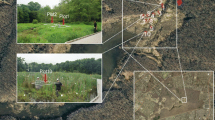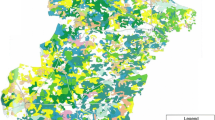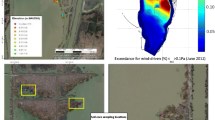Abstract
We examined two types of groundwater-fed wetlands (riparian depressions and slopes) classified using the hydrogeomorphic (HGM) system. These wetland types had previously been shown to differ hydrologically. Our first objective was to determine if HGM was a useful structuring variable when examining aboveground decomposition dynamics (rate of mass loss and rate of nitrogen loss). Our second objective was to determine what soil variables were related to any differences in aboveground decomposition dynamics we might find regardless of HGM subclass. We used the litterbag field bioassay technique, and employed a standard litter type (Phalaris arundinacea) across all wetlands. Our results indicated that HGM would not readily serve as an adequate structuring variable for aboveground decomposition in riparian depressions and slope wetlands of central Pennsylvania. Discriminant analysis and classification and regression tree (CART) modeling found soil cation exchange capacity, soil pH, soil organic matter, and soil % nitrogen to be potentially important soil variables related to mass loss, and soil % nitrogen and soil pH to be potentially important variables related to nitrogen loss rate.





Similar content being viewed by others
Abbreviations
- HGM:
-
Hydrogeomorphic
References
Aaerts R (1997) Climate, leaf litter chemistry and leaf litter decomposition in terrestrial ecosystems: a triangular relationship. Oikos 79:439–449
Atkinson RB, Cairns JJ (2001) Plant decomposition and litter accumulation in depressional wetlands: functional performance of two wetland age classes that were created via excavation. Wetlands 21:354–362
Baker TT, Lockaby BG, Conner WH, Meier C, Stanturf JA, Burke MK (2001) Leaf litter decomposition and nutrient dynamics in four southern forested floodplain communities. Soil Sci Soc Am J 65:1334–1347
Battle JM, Golladay SW (2001) Hydroperiod influence on breakdown of leaf litter in cypress-gum wetlands. Am Midl Nat 146:128–145
Belyea LR (1996) Separating the effects of litter quality and microenvironment on decomposition rates in a patterned peatland. Oikos 77:529–539
Berg B, McClaugherty A (2003) Plant litter: decomposition, humus formation, carbon sequestration. Springer-Verlag, Heidelberg
Berg B, McClaugherty A, Johansson M (1993) Litter mass-loss rates in late stages of decomposition at some climatically and nutritionally different pine sites. Can J Bot 71:680–692
Bergman I, Svensson BH, Nilsson M (1998) Regulation of methane production in a Swedish acid mire by pH, temperature and substrate. Soil Biol Biochem 30:729–741
Bremner JM (1996) Nitrogen-total. In: Sparks DL (ed) Methods of soil analysis, part 3. Chemical methods. American Society of Agronomy, Madison, WI, pp 1085–1121
Brinson MM (1981) Primary productivity, decomposition and consumer activity in freshwater wetlands. Annu Rev Ecol Syst 12:123–161
Brinson MM (1993a) Changes in the functioning of wetlands along environmental gradients. Wetlands 13:65–74
Brinson MM (1993b) A hydrogeomorphic classification for wetlands. Tech Rep WRP-DE-4, U.S. Army Corps Eng. Waterways Experiment Station, Vicksburg, MS
Brooks RP, Wardrop DH, Bishop JA (2002) Watershed-based protection for wetlands in Pennsylvania: levels 1&2: synoptic maps and rapid field assessments. Final report to Pennsylvania Department of Environmental Protection—Penn State Cooperative Wetlands Center, Pennsylvania State University, University Park, PA
Campbell CR (1991) Determination of total nitrogen in plant tissue by combustion. In: Plank CO (ed) Plant analysis reference procedures in the Southern region of the United States. Southern region coop. ser. bull. 368, Georgia Agric. Exp. Stn., Univ. of Georgia, Athens, pp 21–23
Cole CA (2002) The assessment of herbaceous plant cover in wetlands as an indicator of function. Ecol Ind 56:1–7
Cole CA, Brooks RP (2000) Patterns of wetland hydrology in the Ridge and Valley Province, Pennsylvania, USA. Wetlands 20:438–447
Cole CA, Brooks RP, Wardrop DH (1997) Wetland hydrology as a function of hydrogeomorphic (HGM) subclass. Wetlands 17:456–467
Cole CA, Cirmo CP, Wardrop DH, Brooks RP, Peterson-Smith J (2008) Transferability of an HGM wetland classification scheme to a longitudinal gradient of the central Appalachian Mountains: initial hydrological results. Wetlands 28(2) (in press)
Couteaux M-M, Bottner P, Bjorn B (1995) Litter decomposition, climate and litter quality. Trends Ecol Evol 10:63–66
Eckert D, Sims JT (1995) Recommended soil pH and lime requirement tests. In: Sims T, Wolf A (eds) Recommended soil testing procedures for the northeastern United States. Northeast regional bulletin #493. University of Delaware, Newark, DE, pp 11–16
Elliott WM, Elliott NB, Wyman RL (1993) Relative effect of litter and forest type on rate of decomposition. Am Midl Nat 129:87–95
Gambrell RP, Patrick WH (1978) Chemical and microbiological properties of anaerobic soils and sediments. In: Hook DD, Crawford MM (eds) Plant life in anaerobic environments. Ann Arbor Science Publications, Inc., Ann Arbor
Gartley K (1995) Recommended soluble salts tests. In: Sims T, Wolf A (eds) Recommended soil testing procedures for the northeastern United States. Northeast regional bulletin #493. University of Delaware, Newark, DE, pp 70–75
Gartner TB, Cardon ZG (2004) Decomposition dynamics in mixed-species leaf litter. Oikos 104:230–246
Gee GW, Bauder JW (1986) Particle size analysis. In: Klute A (ed) Methods of soil analysis, part 1. Physical and mineralogical methods. Agronomy monograph #9. Amer Soc Agron, Madison, WI, pp 383–411
Groffman PM, Axelrod EA, Lemunyon JL, Sullivan WM (1991) Denitrification in grass and forest vegetated buffer strips. J Environ Qual 20:671–674
Groffman PM, Hanson GC, Kiviat E, Stevens G (1996) Variation in microbial biomass and activity in four different wetland types. Soil Sci Soc Am J 60:662–669
Gurtz ME, Tate CM (1988) Hydrologic influences on leaf decomposition in a channel and adjacent bank of a gallery forest stream. Am Midl Nat 120:11–21
Harmon NE, Nadelhoffer KJ, Blair JM (1999) Measuring decomposition, nutrient turnover, and stores in plant litter. In: Robertson GP et al (eds) Standard soil methods for long-term ecological research. Oxford University Press, New York, pp 202–240
Heal OW, Anderson JM, Swift MJ (1997) Plant litter quality and decomposition: an historical overview. In: Cadisch G, Giller KE (eds) Driven by nature. Plant litter quality and decomposition. CAB International, Wallingford, pp 1–30
Kao JT, Titus JE, Wei-Xing Z (2003) Differential nitrogen and phosphorus retention by five wetland plant species. Wetlands 23:979–987
Kochy M, Wilson SD (1997) Litter decomposition and nitrogen dynamics in aspen forest and mixed-grass prairie. Ecology 78:732–739
Kuperman RG, Edwards CA (1997) Effects of acidic deposition on soil invertebrates and microorganisms. Rev Environ Contam Toxicol 148:35–137
Kurka A, Starr M, Karsisto M, Salkinoja-Salonen M (2001) Relationship between decomposition of cellulose strips and chemical properties of humus layer in natural boreal forests. Plant Soil 229:137–146
Lockaby BG, Murphy AL, Somers GL (1996) Hydroperiod influences on nutrient dynamics in decomposing litter of a flood plain forest. Soil Sci Soc Am J 60:1267–1272
McClaugherty CA, Pastor J, Aber JD, Melillo JM (1985) Forest litter decomposition in relation to soil nitrogen dynamics and litter quality. Ecology 66:266–275
McCune B, Grace JB (2002) Analysis of ecological communities. MjM Software Design, Oregon, US
McLatchey GP, Reddy KR (1998) Regulation of organic matter decomposition and nutrient release in a wetland soil. J Environ Qual 27:1268–1274
Mellilo JM, Aber JD, Muratore JM (1982) Nitrogen and lignin control of hardwood leaf litter decomposition dynamics. Ecology 63:621–626
Mitsch WJ, Gosselink JG (2000) Wetlands, 3rd edn. Wiley, New York
Neckles HA, Neill C (1994) Hydrologic control of litter decomposition in seasonally flooded prairie marshes. Hydrobiologia 286:155–165
Neher DA, Barbercheck ME, El-Allaf SM, Anas O (2003) Effects of disturbance and ecosystem on decomposition. Appl Soil Ecol 23:165–179
Olson JS (1963) Energy storage and the balance of producers and decomposers in ecological systems. Ecology 44:322–331
Palm CA, Rowland AP (1997) A minimum dataset for characterization of plant quality for decomposition. In: Cadisch G, Giller KE (eds) Driven by nature. Plant litter quality and decomposition. CAB International, Wallingford, pp 379–392
Reddy KR, D’Angelo EM (1994) Soil processes regulating water quality in wetlands. In: Mitsch WJ (ed) Global wetlands: old world and new. Elsevier Science, Amsterdam, The Netherlands, pp 309–324
Rheinhardt RM, Brinson M, Farley PM (1997) Applying wetland reference data to functional assessment, mitigation and restoration. Wetlands 17:195–215
Schmidt EL, Ruschmeyer OR (1958) Cellulose decomposition in soil burial beds. I. Soil properties in relation to cellulose degradation. Appl Microbiol 6:108–114
Schulte EE (1995) Recommended soil organic matter tests. In: Sims T, Wolf A (eds) Recommended soil testing procedures for the northeastern United States. Northeast regional bulletin #493. University of Delaware, Newark, DE, pp 47–56
Shaffer PW, Kentula ME, Gwin SE (1999) Characterization of wetland hydrology using hydrogeomorphic classification. Wetlands 19:490–504
Silver WL, Miya RK (2001) Global patterns in root decomposition comparisons of climate and litter quality effects. Oecologia 129:407–419
Smith VC, Bradford MA (2003) Do non-additive effect on decomposition in litter-mix experiments result from differences in resource quality between litters? Oikos 102:235–242
St. John TV (1980) Influence of litterbags on growth of fungal vegetative structures. Oecologia 46:130–132
Swift MJ, Heal OW, Anderson JM (1979) Decomposition in terrestrial ecosystems. Blackwell Scientific, London
Tabachnick BG, Fidell LS (2001) Using multivariate statistics, 4th edn. Allyn and Bacon, Needham Heights, MA
Van der Valk AG, Rhymer JM, Murkin HR (1991) Flooding and the decomposition of detritus in four emergent plant species in a prairie wetland. Wetlands 11:1–16
Wanner M, Funke I, Funke W (1994) Effects of liming, fertilization and acidification on pH, soil moisture, and ATP content of soil from a spruce forest in southern Germany. Biol Fertil Soils 17:297–300
Wardrop DH, Brooks RP (1998) The occurrence and impact of sedimentation in central Pennsylvania wetlands. Environ Monitor Assess 51:119–130
Witkamp M, Olson JS (1963) Breakdown of confined and nonconfined oak litter. Oikos 14:138–147
Wrubleski DA, Murkin HR, Van der Valk AG, Nelson JW (1997) Decomposition of emergent macrophyte roots and rhizomes in a northern prairie marsh. Aquat Bot 58:121–134
Zimmer M (2002) Is decomposition of woodland leaf litter influenced by its species richness. Soil Biol Biochem 34:277–284
Acknowledgments
We thank S. Goslee, R. Koide, and D.H. Wardrop for thoughtful suggestions, questions, and comments on this project. A special thanks to Nick Reeder and Earl Hough for countless hours of field help. This research was supported in part by an EPA STAR grant No. R-82949701-0 and a 2004 Society of Wetland Scientists student research grant.
Author information
Authors and Affiliations
Corresponding author
Rights and permissions
About this article
Cite this article
Hough, Z., Cole, C.A. Aboveground decomposition dynamics in riparian depression and slope wetlands of central Pennsylvania. Aquat Ecol 43, 335–349 (2009). https://doi.org/10.1007/s10452-008-9198-3
Received:
Accepted:
Published:
Issue Date:
DOI: https://doi.org/10.1007/s10452-008-9198-3




